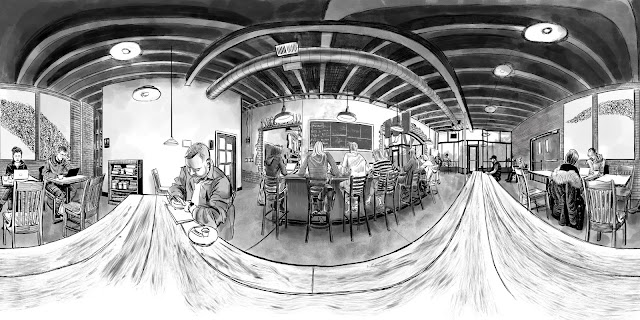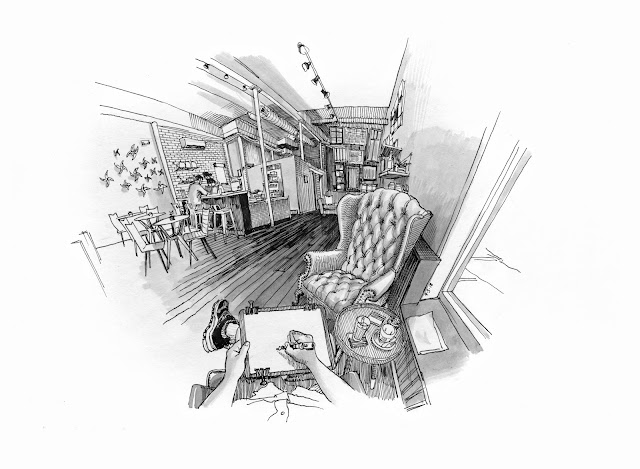How I Draw Spherical Panoramas

Ever since I first sketched a spherical panorama in the Procreate app, people have been asking for a tutorial, so I've finally put together the steps for how I did it. I had seen illustrations that you can pan around before and I wanted to figure out a way to do one on site, rather than make it in my studio from photo references. I will start by saying that panoramic urban sketches done on location are nothing new. The brilliant Gérard Michel and Arno Hartmann have been doing them for some time, and Arno had already been taking his analog images done on site and turning them into scrollable panos with computer software years before I set out to try this.
Most of the time when I draw in curved perspective I draw "intuitively," meaning I don't set up any vanishing points or use any rulers or grids. In researching this process I knew that to do a 360 degree drawing accurately I would need an equirectangular grid with 2:1 proportions. I found one, along with a ton of other very useful information, on DM Swart's website.
I loaded his 3600 x 1800 pixel grid into a Procreate file, created a new layer on top of it, and started sketching my living room, from life, on that layer.
The goal was to have a drawing that looks like a spherical panoramic photo. Only because the drawing is just a flat image, I needed to edit the the metadata or EXIF information associated with the raster file so that Facebook and other sites that support interactive 360 images would recognize it as a photo taken by a 360 camera. I used the free EXIF editor site https://www.thexifer.net/ to do this. This part was surprisingly easy. I uploaded my jpg file (minus the grid) onto the site, hit "edit," and added "Ricoh" and "Ricoh Theta S" (a 360 camera) to the make and model fields in the EXIF editor. Then I exported the image and did a test upload to Facebook and it worked! I couldn't believe it.
That's the whole process. Since then I've also done two more in the Procreate app on my iPad and one pen and ink drawing on a grid I printed out. The trickiest part is probably reconciling what you are seeing and sketching with the equirectangular grid. It takes some practice, and fortunately I'd done lots of exploring with curved perspective for years so I was better prepared for the challenge. The drawings themselves also just take a long time because you are drawing literally everything around you in all directions, instead of cropping to a relatively small field of view as in most sketches. The process took a lot of trial and error, but it went smoother than I anticipated. You can see all my 360 sketches to date here: https://kuula.co/profile/paulheaston






Wow! You're talented!
ReplyDeleteAqualine Steel Rainwater Tanks
You've got a talented hands...
ReplyDeleteIndiana Foundation Repair
Hi nice reading yyour blog
ReplyDeletedraw x tipsprovides expert drawing tips and techniques to enhance your artistic skills. Perfect for beginners and professionals looking to improve their craft.
ReplyDeleteThis is a fantastic post! Capturing and presenting images in a unique and engaging way is essential for storytelling and marketing. 360-degree photography has become increasingly popular for real estate, eCommerce, and virtual tours, providing viewers with an immersive experience. However, high-quality editing is crucial to enhance image clarity, correct distortions, and ensure seamless stitching. A professional 360-degree photo editing service helps refine and perfect these images for a polished, professional look. Thanks for sharing this valuable content—excited to see more insights on creative photography techniques!
ReplyDeleteYour blog on 3D visualization is truly impressive! The way you’ve explained its impact on architecture and real estate is both insightful and engaging. I particularly appreciate your emphasis on how 360 virtual tour technology enhances buyer experiences, making property exploration more immersive and convenient. Your deep knowledge and well-structured explanations provide great value to professionals and enthusiasts alike. Looking forward to reading more of your expertise—keep up the amazing work in sharing industry-changing innovations!
ReplyDeleteWow, I love how you break down the process of drawing spherical panoramas—such a cool way to capture a space! If anyone's looking to get creative with their images, there's a handy tool for pixelating them that could add a fun twist to your work too! Pixelate Image Online
ReplyDeletebrilliant job
ReplyDeleteYour process for drawing spherical panoramas is photosweek really inspiring and detailed. I love how you explained the perspective and curvature techniques so clearly. This post is super helpful for artists wanting to explore 360° art creation.
ReplyDelete